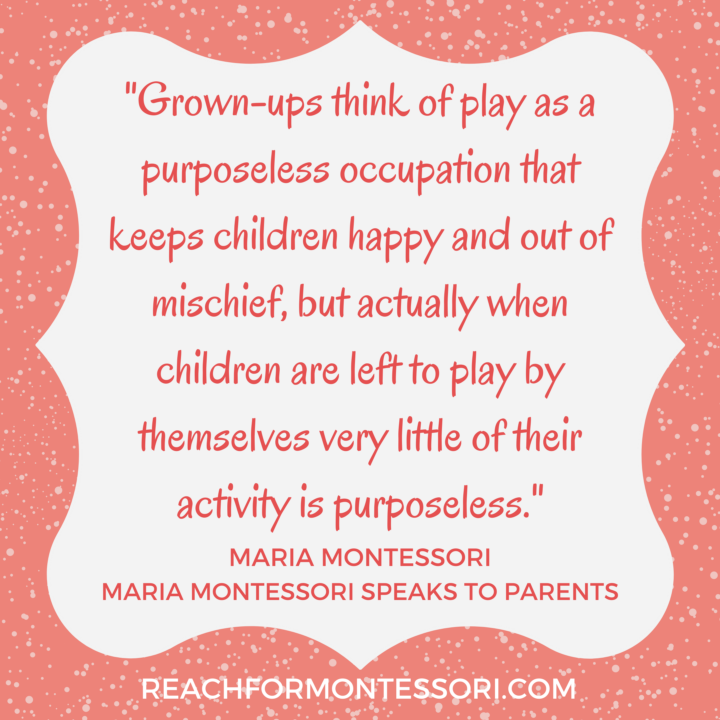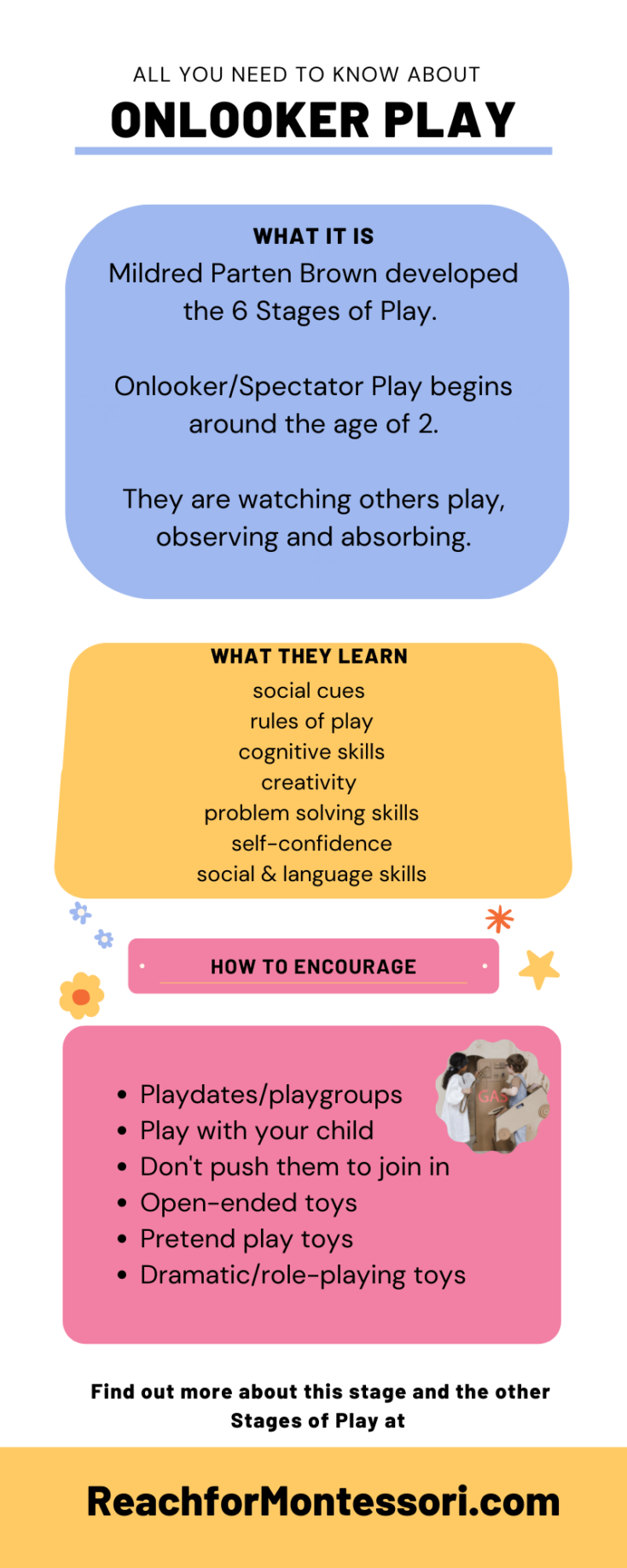In this article, you will learn all about the developmental stage of play called Onlooker Play.
You will learn what it is, at what age it occurs, and you will get some ideas on how to support this type of play in your toddler.

(This post contains affiliate links. Purchasing from these links costs you nothing extra, but helps with our website upkeep.)
Here at the Montessori-Minded Mom, we have frequently discussed the importance of FREE PLAY.
Child-led play is important for any child, at any stage.
Play has connections to better emotional regulation, creative thinking, and increased language and social skills.
During play, they are learning so much more than we realize.

What is Onlooker Play?
Onlooker, which is sometimes referred to as Spectator Play, is one of the 6 Stages of Play developed by sociologist, Dr. Mildred Parten Newhall. The other 5 stages of play are:
- Unoccupied Play
- Independent Play
- Parallel Play
- Associative Play
- Cooperative Play
Read more about the 6 Stages of Play here.
Onlooker/Spectator play usually begins sometime around the age of 2. During this stage, they are simply watching other children play.
They are observing what the other child(ren) are doing and taking it all in.
The child will stand at a comfortable distance, where they can hear the child(ren). They may ask questions, or talk to the other child(ren), but won’t join in.
Just like during infancy's unoccupied play, they have a natural desire to watch and learn.
Onlooker play will usually overlap with the independent play stage and may continue as they progress to the next stage.
Example:
When my daughter was younger, I took her to the playground where she watched two older preschoolers play “restaurant” at a window-type opening on the playscape.
She didn't want to join in, and I respected that. She enjoyed watching them from a short distance, smiling and laughing at what they were doing.
The next time we went to the playground, she used the window in the same way, adding on her own ideas by using rocks as money.
Now at 3.5 years old, she still uses the window as a restaurant and includes her younger sister or other kids.
Why Is Onlooker Play Important?
You may be asking yourself: “But don’t we want our children to play with other children?” or “What are they getting out of just watching?”
Well, the truth is, this stage is a vital milestone, and they cannot progress to the next stages without first developing skills through being an onlooker.
During this stage, they are paying attention to everything the other children are doing; different ways a child might be using a toy, or how children interact with each other.
During this stage they learn:
- social cues
- rules of play (I.e., taking turns)
- creativity
- social and language skills
- cognitive skills
- self-confidence
- problem-solving skills
Sometimes, parents or caregivers think the child is just ”shy” and needs to be pushed to join in. But resist the urge to push the child into interacting.
They may be just in this important stage of being a spectator.
I feel that it’s worth mentioning that there is actually nothing wrong with being or feeling shy, and it's important to respect a child's boundaries.

How to Support Onlooker Play
This stage happens naturally but as always, there are ways to encourage your child's development during this time.
- Playdates and playgroups. This may seem pointless if they're not playing together, but it gives them new opportunities to be a spectator.
- Trust and support your child. Trust that when they’re ready, they will play with other children. Respect when they would prefer to watch and let them know they can join in when they want to.
- Play with your child. While children tend to learn more from other children during this stage, you still can model playing to help them pick up skills. They will learn social skills and cues just by watching you as well.
This doesn't mean you have to play with them all day long – we still want to encourage independent play.
But if you feel like your child is missing it out on chances to be an onlooker during play, it doesn’t hurt to set aside some time to provide that yourself.
Toys to Support Onlooker Play
Open-ended toys
Open-ended toys are toys that can be played with in a variety of different ways, allowing children to be creative in their play.
Toys that have one purpose or goal, like puzzles or Montessori knobbed cylinders, are close-ended toys.
Examples of open-ended toys:
- Blocks
- Rainbow stacker
- Magna-tiles
- Play silks
- Playdough
- Cardboard box
- Legos
- Loose parts
- Train set/cars
Read more about open-ended toys and more of our suggestions here.
Pretend play
Pretend play is imaginative play using role-play and sometimes object substitution. It is sometimes called make-believe or dramatic play.
Examples of pretend play toys:
- dress up clothes/costumes
- Play kitchen
- Play food (check out this list of play food sets)
- Cash register
- Doctor or vet kit
- Dollhouse or barn
- Animal figures
- Baby dolls
In a study by Jessica Hoffman and Sandra Russ, it was found that pretend play resulted in higher scores for emotional regulation and divergent thinking. Find that study here.
Children have a natural instinct to play, but also to observe.
By supporting this natural instinct, you will start to see how their observations start to show up in their own independent play.
As well, you will see how it leads to the other stages of play.
As always, it's important to remember that every child develops at different rates and some children may take a little longer to get to this stage.
However, if you have any concerns regarding their reluctance to join in, or if they don't seem to be reaching this stage, it doesn't hurt to mention it to your pediatrician.
